Importance of Long-term Trending Markets in Investment Risk Management
InvestorEducation / Learning to Invest Jul 25, 2008 - 11:16 AM GMTBy: Chris_Ciovacco
 Long-Term Investors Need Trends to Make Money - Most of us would prefer to be investors instead of traders. Investors, with an intermediate to long-term time horizon, must be aligned with a positive trend in order to make money. This is true even for value investors who focus on a company's valuation rather than a trend that can be seen on a chart. For the value investor to make money, eventually the position must turn up.
Long-Term Investors Need Trends to Make Money - Most of us would prefer to be investors instead of traders. Investors, with an intermediate to long-term time horizon, must be aligned with a positive trend in order to make money. This is true even for value investors who focus on a company's valuation rather than a trend that can be seen on a chart. For the value investor to make money, eventually the position must turn up.
The chart above is not designed to convey that spotting a trend reversal is easy. It is not, but as more evidence gathers as to the probable legitimacy of the new trend, the less risk you need endure to participate. If the stock or market does not trend upward for a significant period of time, long-term investors do not want to participate.
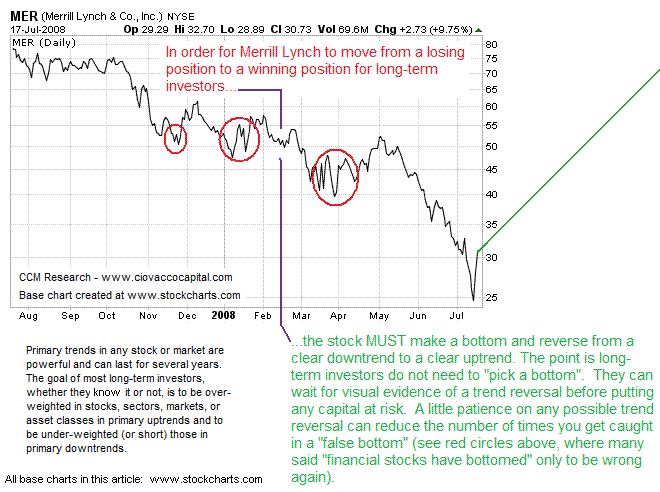
The point is you can afford to miss the early part of the new trend. Let the traders show us the way while putting their capital as higher risk. The strategies and goals of shorter-term traders are quite different from those of a long-term investor. When you understand this, it becomes clear that many buyers at a "bottom" are traders who have no intention of keeping the stock for a long-term investment, which means they will be happy to sell at the first sign of trouble (creating many false bottoms). Long-term investors do not necessarily want to enter a market at the same time as traders who have much shorter holding periods. This concept currently applies to the ETFs SPY, QQQQ, DIA, XLF, EFA, and the list goes on.
Volatility and Risk Management While Capturing a Trend
Depending on how you manage it, volatility can be your friend or your enemy when attempting to make money in financial markets. Fear is an investor's biggest enemy and volatility is what drives fear. To remind everyone of what could be at stake here and what can happen in bear markets, below are the devastating losses suffered in the S&P 500 (SPY) and NASDAQ (QQQQ) during the 2000-2002 bear market.
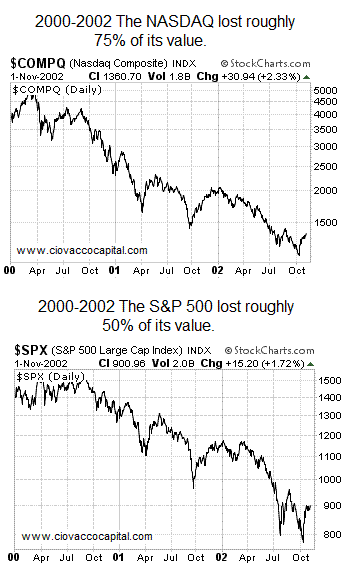
It is evident above that volatility should be respected since losses can wipe out years of hard work if a portfolio manager does not adopt proper risk management measures. How can volatility be our friend? Those who study and understand the volatility characteristics of any investment or market will have a much better chance of staying with and capturing the gains available in long-term trending markets. As illustrated in Chart A below, any investor would have loved to ride the NASDAQ's meteoric rise from 1995 through the first quarter of 2000. I have removed the volatility from Chart A to illustrate a trending market without the gut-wrenching and emotional effects of the market's inevitable ups and downs within the context of the primary trend. Our goal is to stay in an upward trending market long enough to profit, while not staying invested too long during what appears to be more than a "normal" correction (see Chart C).
Chart A

Chart B
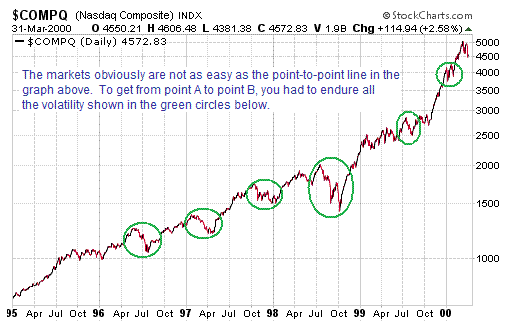
Chart C
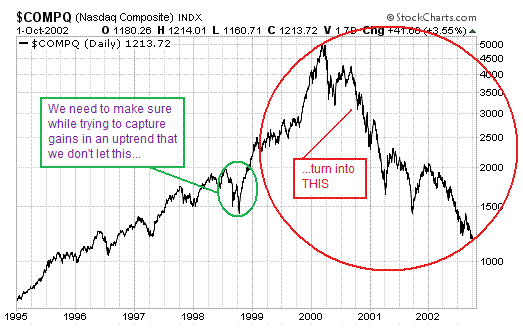
Chart D (below) shows both the current uptrend in oil (USO) and recent corrections within the context of the uptrend. The percentage drop in the large pink circle from peak to trough was 34%, but those who held even a reduced position were able to profit from the remainder of the trend. The percentage drop in the green circle was 13%, but those who held on through the correction were able to profit. If oil dropped 12% from its recent peak of $145 it would fall to $127.50. If oil dropped 34% from its recent peak, it would fall to $95.95. In a form more simple than how we would actually make decisions, an investor in oil should not get too concerned until $127.50 is taken out on the downside. Based on your risk tolerance, you may decide to cut back on your holdings below $127.50. If $95.95 is violated on the downside, it is possible you would exit the entire position or at least make a significant reduction in your exposure.
Chart D
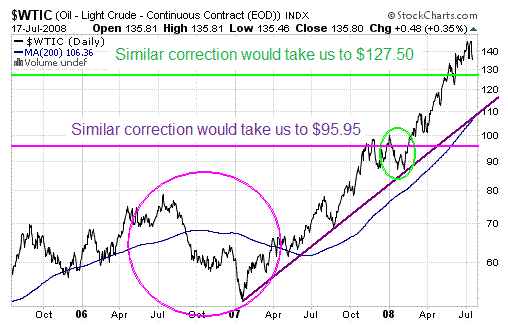
In the real world, a portfolio manager would use several factors to make calls on when to cut back or exit a position. If trend lines are broken that adds to the negative evidence. If an investment has had an extended run, like oil, the manager may be more inclined to cut back earlier rather than later. Fundamental factors come in to play as well. The cons for oil are the reduction in demand that comes during periods of economic weakness and the aforementioned long in the tooth trend. The pros for oil are well known; questions about supply and increased demand from China, India, etc.
Let's Put Some Charts on a Wall
As shown in the chart below of a resource stock mutual fund, the long-term trendline from 2002 in commodity stocks has been breached. The closing price of PSPFX has now breached levels which move the current declines beyond a "normal correction" for this investment. While we are not calling a top, the evidence we have should be used in your risk management efforts.

It is worth keep an eye on the depth of the current pullback in gold mining stocks. A new high in TGLDX, a mutual fund, has not been made in quite some time.

The great bull market in stocks began in 1982 after years of lackluster inflation adjusted returns. The chart below shows the trendline from 1982 has now been broken.
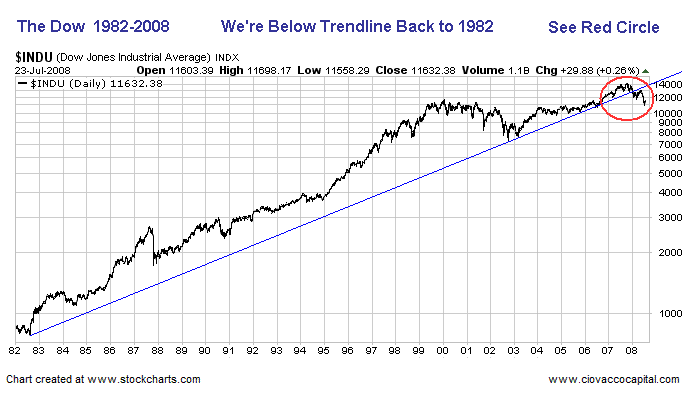
While financial stocks have hit a violent intermediate bottom and could rally for a while longer the odds favor lower lows in the months ahead as housing prices continue to decline. The chart below illustrates the structural nature of the problems facing the housing and financial industry. There are fundamental reasons financial stocks have been hit so hard, reasons which go way beyond short selling. Additional bank failures in the coming months would not come as a surprise, which is supported by the rapid deterioration of the sector. Since our economy has become so dependent on the availability and use of credit, these problems will continue to impact U.S. and global growth.

A recent Bloomberg article illustrates the vast difference between supply and demand in housing. The banks and GSEs (Fannie & Freddie) are overloaded with foreclosures. Vandals often step in making homes near impossible to sell.
July 23 (Bloomberg) -- Fannie Mae, the largest U.S. mortgage finance company, couldn't find a buyer who would pay $6,900 for the three-bedroom house at 1916 Prospect St. in Flint, Michigan. So broker Raymond Megie, who is handling the foreclosure sale, advised cutting the price to $5,000. Megie still couldn't sell it. "There's oversupply," he said. The home sold in 2005 for $110,000.
Banks around the globe, especially in Europe, are facing similar problems with mortgage losses.
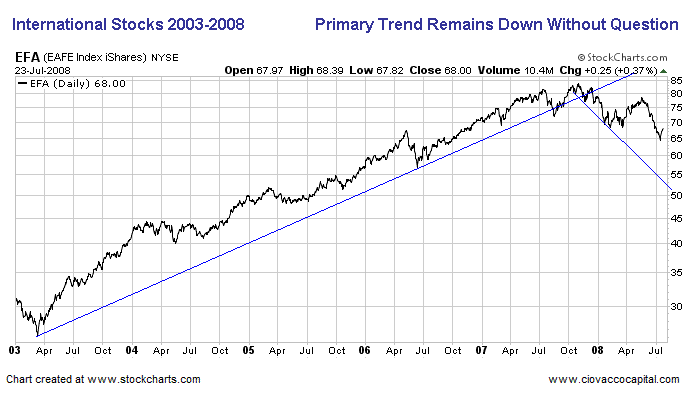
I once read where a very successful money manager said he liked to invest in trends where if he printed a graph and taped it to the wall, he would be able to spot the trend from across the room. Let's tape up some charts to get a read on the current state of the world. The charts below are one-year charts which are more relevant to your current portfolio. We'll start with global stock markets since most investors who wish to grow and protect their purchasing power tend to invest in stocks. Related EFT symbol is shown in parenthesis.
The S&P 500: Clear Downtrend (SPY)
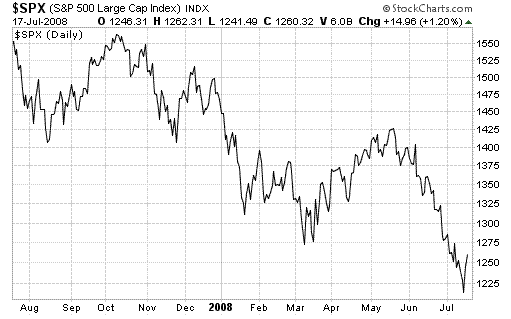
The Dow: Clear Downtrend (DIA)
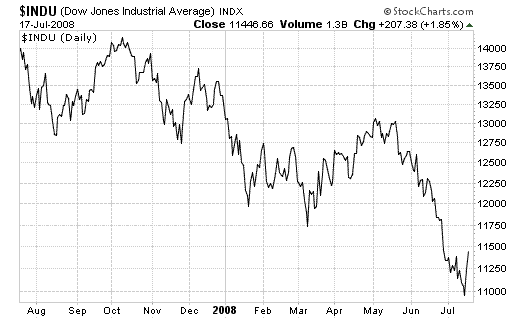
The NASDAQ: Clear Downtrend (QQQQ)
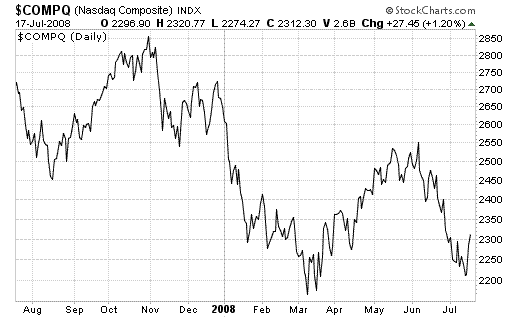
Foreign Developed Markets: Clear Downtrend (EFA)

Emerging Market Stocks: Downtrend, But Not As Defined As Those Above (EEM)
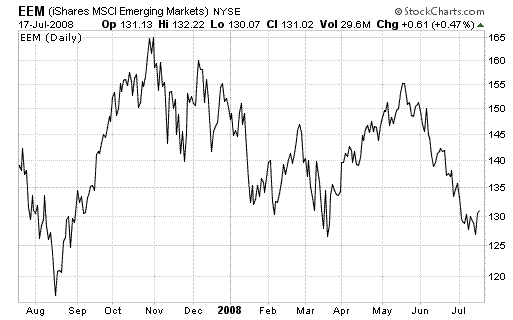
U.S. Financial Stocks: Clear Downtrend (XLF was overdue for a bounce)
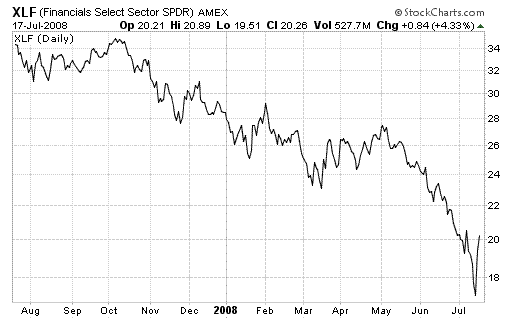
To invest with the trends above, maybe with the exception of the Emerging Markets, you would use inverse funds or ETFs, which rise as the underlying index falls. This may sound somewhat radical, but from a portfolio manager's perspective, the inverse funds are managed just like any other investment. For example, below is the inverse ETF for U.S. financial stocks (it is 2x the inverse of the index).
Inverse U.S. Financials: Clear Uptrend – Concerning Correction (SKF)

To Make Money Find Trending Investments
Based on the charts of most stock markets above, the trends will have to change before long-term investors can again make money. If a trend has to be in your favor to make money, then you should overweight investments which are doing just that. The inverse Financial ETF above fits the bill. Let's see what other markets are in clearly defined trends.
Commodities: Clear Uptrend (DBC)

Commodities are experiencing a long-overdue correction as I type. Based on past corrections above, within the context of the ongoing uptrend, the current correction is not yet alarming (in physical commodities - stocks are more of a concern). However, you should watch the situation closely due to the slowing global economy and recent run-ups in prices. The commodity bull-run will end some day, but we don't need to call a top. We can wait for evidence to mount which supports the probability of a trend reversal. Look at the sharp correction which occurred in March of this year. The press and many professionals called a top in commodities for the countless time during this bull-run. The gain from the March bottom is significant.
Please do not interpret these comments as bullish. A top will come – it may be happening right now – but even if this is “the top”, in the long run in order to stay with profitable trends, you are better off waiting for more evidence prior to giving up on commodities. We may be wrong doing so now, but over time and over many instances we will be right more often than not, which is an important concept in the process of making money. One way to help take some emotion out of the decision making process is to make consistent decisions based on specific criteria. You evaluate the decision based on its merits rather than on the outcome. In the markets, to make money we know we can still be wrong on some decisions as long as we do not let the losses run too far. Risk control, which includes cutting losses, is important in all markets, including commodities. Moving on to other markets or investments which are currently trending favorably:
Gold: Uptrend, But Taking A Breather (GLD)
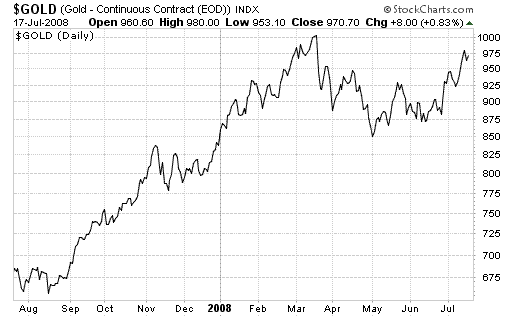
Metals & Mining Stocks: Uptrend, But Correction of Concern (XME)
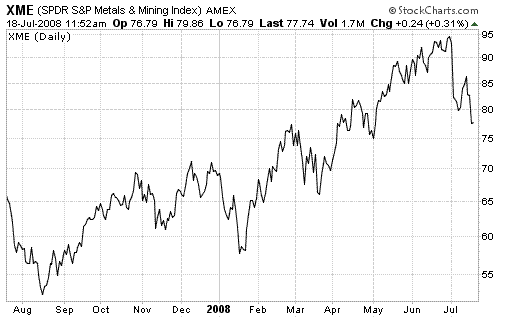
Agricultural Stocks: Uptrend, But Correction of Serious Concern (DBA)
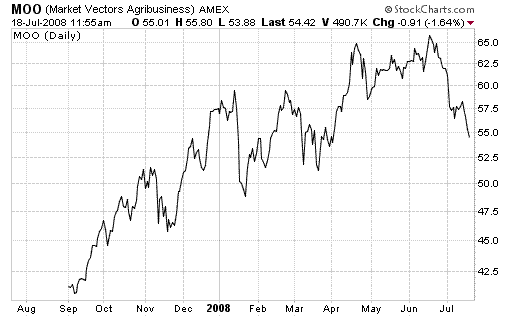
Agricultural Commodities: Uptrend, But Currently Drifting (MOO)
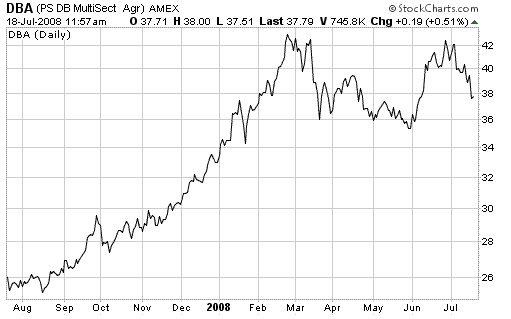
Steel Stocks: Uptrend, But Correction a Concern (SLX)
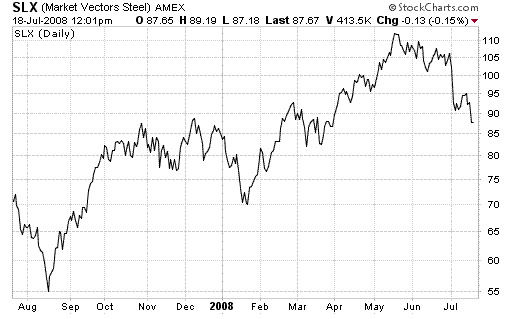
Energy Stocks: Uptrend, But Once Again Current Correction Very Concerning (XLE)
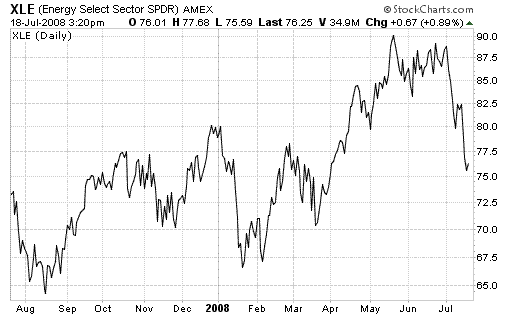
U.S. Dollar Index: Firm Downtrend, But…
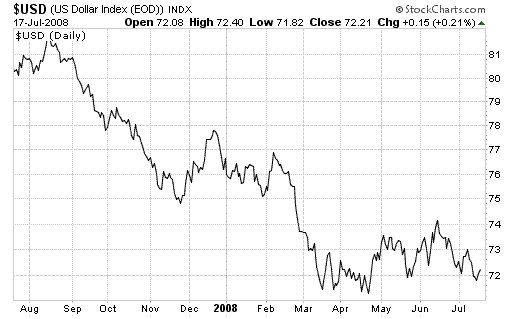
… Investments Can Take Advantage Of The Weak Dollar (CYB, MERKX, etc.)
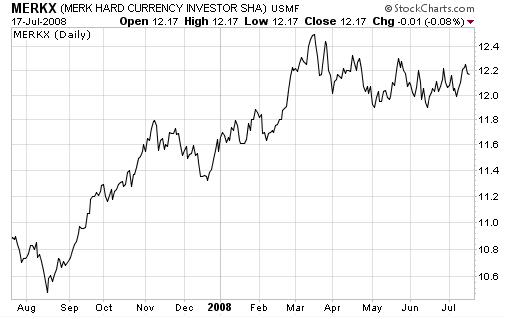
You may have noticed that all the up trending markets are commodity related or weak dollar related. Since commodities have a strong correlation to a weak dollar it is obviously a concern in terms of portfolio risk. In recent months we have continually searched for other alternatives with very limited success.
Biotech Stocks: Not a Strong Trend, But Better than the S&P 500 (XBI)
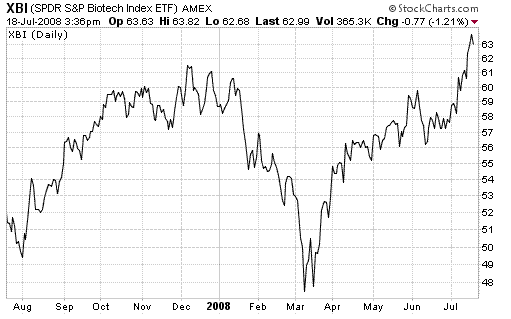
Medical Device Stocks: Not Really Very Attractive (IHI)
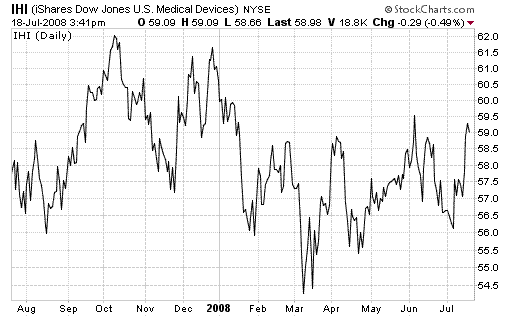
Since there are very few markets trending upward, the inverse funds of downward trending markets offer some alternatives to commodity and weak dollar plays. Shorting and inverse investments should be managed by experienced investors or experienced professionals due to their high volatility and rapid price moves.
2x Inverse S&P 500: Clear Uptrend
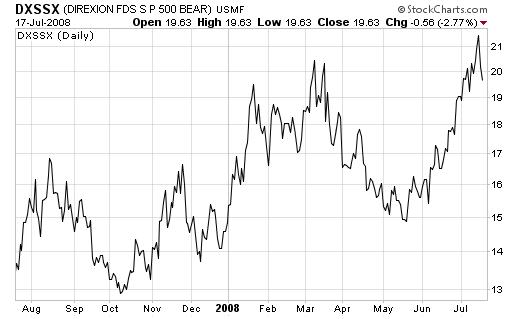
2x Inverse EAFE / Developed Foreign Markets Stocks: Volatile, But Profitable
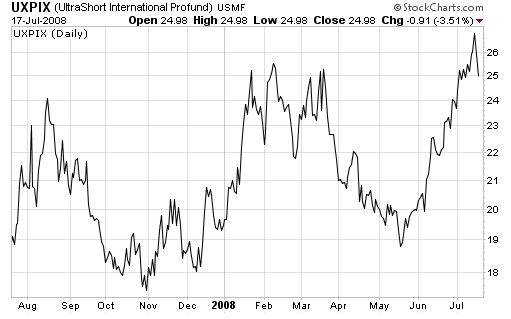
In an attempt to provide some diversification to counterbalance the commodity and weak dollar plays, we also have other somewhat attractive investment options.
Long-Term U.S. Treasury Bonds: Inflation A Concern (TLT)
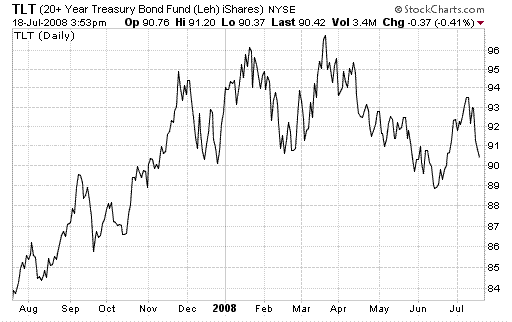
Timber: Good on a Relative Basis, But No Strong Trend
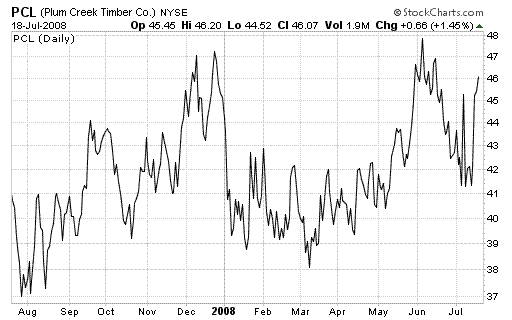
Investment Correlations to Inflation (CPI) Point Toward Higher Inflation
In a recent analysis conducted by PIMCO and Morgan Stanley which explored the correlation of S&P 500 Industry Groups to inflation (CPI) from 1975-2007, the groups with positive correlations to inflation (CPI) were quite limited in scope. Only energy, media, healthcare equipment & services, transportation, materials, utilities, and food & staples, were able to post positive returns as inflation rose.
The remaining fourteen industry groups including diversified financials, banks, tech hardware & equipment, and telecom services all were losing bets during periods of rising inflation. If you look at the positive trending charts above, it is quite clear history is repeating itself. It is interesting to note, the S&P 500 as a whole posted a strong negative correlation to the CPI from 1975-2007, which means if inflation continues to pick up steam, stocks will be fighting an ongoing historical headwind.
A Word about Position Sizing Within the Context of the Entire Portfolio
Investors will be well served in the current environment to more closely monitor their portfolio as a whole, rather than isolating more volatile components such as gold (GLD) or financial stocks (SKF). If the percent allocation or size of the position is small or within reasonable bounds relative to the balance of the portfolio, the risk of volatility has been properly accounted for. For example, if your allocation to physical gold is 5% of your entire portfolio, including CDs and money markets, a 20% fall in the price of gold will only cause a 1% decline of your total holdings. A 1% decline is much easier to stomach than a 20% decline.
Housing, Fannie & Freddie, and Financial Stocks
You often hear defenders of Fannie and Freddie's say, "Most of their mortgages are 30-year fixed and not delinquent." That is somewhat accurate, but leaves out the ongoing damage to their balance sheet as housing prices continue to fall. You can make all the payments you want on time and that has no effect in terms of the blow to the value of their mortgages which results when the underlying assets, single family homes, drop in price. The text below, concerning Fannie and Freddie, is from the Wall Street Journal dated Friday, July 18, 2008:
The two companies – which are rivals in the same business – have reported a combined $11 billion of losses over the past three quarters, largely because of increasing defaults by homeowners on mortgages. When homeowners don't make mortgage payments, Fannie and Freddie must reimburse the holders of securities backed by those defaulting mortgages. At the same time, falling home prices cut the value of the collateral backing the loans, increasing losses for Fannie and Freddie. Investors and analysts can only guess how bad the losses might be as several million American homes go through foreclosure. Analysts at Goldman Sachs Group Inc. this week estimated that Fannie faces default-related losses of $32 billion and Freddie $21 billion.
As far as banks, and to a lesser extent the financial markets as a whole go, nothing is more important than falling home prices. Until home prices at least show some real signs of stabilization, all bullish bets or calls for a bottom in stocks should be made cautiously. In my view we cannot even begin to think about stabilization in home prices until the inventory of unsold homes comes back in line with historical norms. The basic laws of supply and demand are still out of balance. Currently, there are somewhere in the neighborhood of eleven months of supply of unsold homes on the market versus a six to seven month supply we would expect to see in a more healthy market for price appreciation. When this gap begins to close, it will be more reasonable to consider lasting rebounds for the economy and stocks.
How Are Value Investors Doing In The Current Environment?
Rather than try to pick on anyone in a tough environment, my purpose here is to demonstrate the limited number of places to seek investment gains in the last year. As most of us know, the king of value investing is Warren Buffet. Historically value investors, who buy companies based mainly on their value as a business, have fared relatively well in bear markets. Even Mr. Buffet's Berkshire Hathaway has not been immune to the bear.
Mr. Buffet May Be Human After All
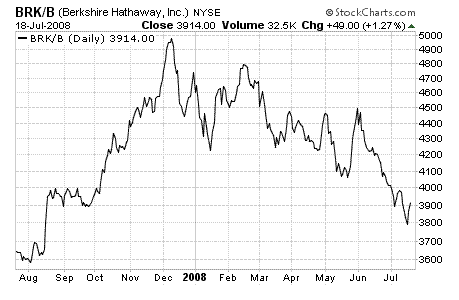
A Tough Environment: Inflation Is Rising, Equity Markets Are Falling, and Commodities Correcting
As a portfolio manager, options in the current environment are somewhat limited. We have no particular fascination with commodities, they just happen to be the only source of strength. We would much prefer never to use inverse funds, but a 100% commodity portfolio is not prudent. Global inflation is on the verge of getting away from central bankers, which means investors who wish to protect their long-term purchasing power cannot afford to park funds exclusively in CDs and money markets. Our approach will continue to use a mix of multiple asset classes in an effort to grow and protect principal within the context of volatile and increasingly interfered with markets. While in an environment where the source of strength is basically limited to commodities and inverse or bear market vehicles, we have to tread with extra care. We are willing to give investments a reasonable amount of rope on the downside based on recent volatility characteristics. However, a continued pullback in commodities could quickly morph into rapidly falling prices. In that event, principal protection must become the primary focus in order to preserve capital to fight another day.
While some shortsighted stock investors see an opportunity in stocks based primarily on a possible correction in commodity prices, they should not ignore the fact that continued global economic deterioration is the driver behind falling commodity prices. This serves as another reason to be skeptical of what appear to be textbook bear market rallies. The markets and economy would be better served if the Feds backed off on the tinkering and just let the markets deal with those who made poor decisions in the form of overbuilding, real estate speculation, securitization, and a general lack of managerial oversight and discipline. Recessions do many things to help the economy move closer to a sustainable recovery including the all important purging of bad debt from the system. Unfortunately, we will most likely see just the opposite from the Feds in the form of continued “unprecedented” intervention into what is inaccurately described as a free market economy. In the end, all the tinkering will simply prolong the recovery process. As always, if we keep an open mind (recognizing things may not unfold as described above) and pay attention to what is actually happening versus being concerned with what may happen, the markets will guide our asset allocations if we are willing to follow.
By Chris Ciovacco
Ciovacco Capital Management
Copyright (C) 2008 Ciovacco Capital Management, LLC All Rights Reserved.
Chris Ciovacco is the Chief Investment Officer for Ciovacco Capital Management, LLC. More on the web at www.ciovaccocapital.com
Ciovacco Capital Management, LLC is an independent money management firm based in Atlanta, Georgia. As a registered investment advisor, CCM helps individual investors, large & small; achieve improved investment results via independent research and globally diversified investment portfolios. Since we are a fee-based firm, our only objective is to help you protect and grow your assets. Our long-term, theme-oriented, buy-and-hold approach allows for portfolio rebalancing from time to time to adjust to new opportunities or changing market conditions. When looking at money managers in Atlanta, take a hard look at CCM.
All material presented herein is believed to be reliable but we cannot attest to its accuracy. Investment recommendations may change and readers are urged to check with their investment counselors and tax advisors before making any investment decisions. Opinions expressed in these reports may change without prior notice. This memorandum is based on information available to the public. No representation is made that it is accurate or complete. This memorandum is not an offer to buy or sell or a solicitation of an offer to buy or sell the securities mentioned. The investments discussed or recommended in this report may be unsuitable for investors depending on their specific investment objectives and financial position. Past performance is not necessarily a guide to future performance. The price or value of the investments to which this report relates, either directly or indirectly, may fall or rise against the interest of investors. All prices and yields contained in this report are subject to change without notice. This information is based on hypothetical assumptions and is intended for illustrative purposes only. THERE ARE NO WARRANTIES, EXPRESSED OR IMPLIED, AS TO ACCURACY, COMPLETENESS, OR RESULTS OBTAINED FROM ANY INFORMATION CONTAINED IN THIS ARTICLE. PAST PERFORMANCE DOES NOT GUARANTEE FUTURE RESULTS.
Chris Ciovacco Archive |
© 2005-2022 http://www.MarketOracle.co.uk - The Market Oracle is a FREE Daily Financial Markets Analysis & Forecasting online publication.
Comments
|
AMANYIRE
05 Dec 08, 07:00 |
wishing u God's blessings.
Let me first thank you for your good work. I really appreciate. |



